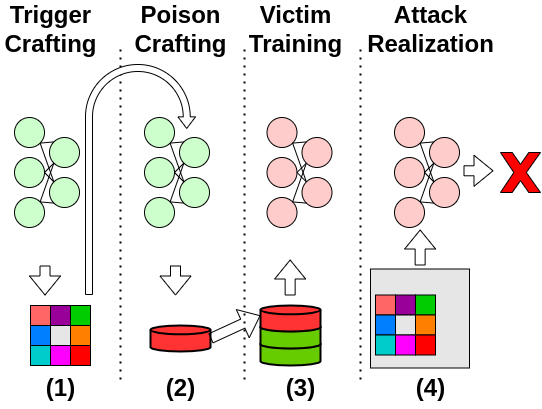The project is the official implementation of the paper Silent Killer: A Stealthy, Clean-Label, Black-Box Backdoor Attack.

All the requirements are listed in requirements.txt.
We run this code with python 3.8.
Run pip install -r requirements.txt to install requirements, and then run the script silent_killer.py.
We demonstrate both attacks, perturbation as trigger and patch as trigger.
The code implements the CIFAR-10 experiments.
Results are available in our WandB project.
To run our main attack:
python silent_killer.py --trigger_type additive --eps 0.062745
To run the baseline (without poisoning):
python silent_killer.py --trigger_type additive --eps 0.062745 --n_samples 0 --crafting_repetitions 0
To run the optimized-patch:
python silent_killer.py --trigger_type adaptive_patch --eps 0.062745 --trigger_opt_eps 1
To run the baseline (without trigger optimization):
python silent_killer.py --trigger_type adaptive_patch --eps 0.062745 --trigger_opt_eps 1 --trigger_opt false --trigger_init_method from_file
- To specify source label and target label use
-sand-tflags. - To log results to wandb specify the entity, for example
--entity jhon. The default project and run name aresilent-killerandbase. To change them use the flags--projectand--name. - To use a pretrained model for crafting rather than retrain one from scratch in the beginning of the crafting
use
--model_path. Our checkpoints are available in this link. please download them and write down the path to the checkpoint--model_path /path/to/checkpoint.pt. Make sure that the checkpoint correspond to the model architecture defined in--craft_model. - The flag
--trigger_typedefines if the trigger will be a small perturbation over all the sample or a small patch. - The flag
--trigger_optdefines if the trigger will be optimized before the poison crafting (see the paper for more details). - The flag
--validation_frequencydefines the amount of times that the victim craft the poison on randomly initialized weights. The ASR will be averaged and reported as Mean ASR.
To reproduce paper results follow these steps:
- Install the dependencies using
pip install -r requirements.txt - Download the weights of the model you want to evaluate from this link.
- Run the script
make_run_file.py, specify the experiment you want to run:python make_run_file.py --wandb_entity your_wandb_entity --model_path path/to/resnet18_cifar10.pt --model_arch resnet18 --trigger_type additive --experiment silent_killerpython make_run_file.py --wandb_entity your_wandb_entity --model_path path/to/resnet18_cifar10.pt --model_arch resnet18 --trigger_type additive --experiment basepython make_run_file.py --wandb_entity your_wandb_entity --model_path path/to/resnet18_cifar10.pt --model_arch resnet18 --trigger_type patch --experiment silent_killerpython make_run_file.py --wandb_entity your_wandb_entity --model_path path/to/resnet18_cifar10.pt --model_arch resnet18 --trigger_type patch --experiment base
- The script will generate a bash file, run it.
- You can see the results on wandb. You can group the runs by name to see the average results.
This will run the experiments of ResNet18 without defences. You can go deeper and change the parameters of the run.
ResNet18 default parameters: --victim_lr 0.1 --victim_milestones 14, 24, 35 --victim_epochs 80.
MobileNet-V2 parameters: --victim_lr 0.1 --victim_milestones 50 100 --victim_epochs 150.
VGG11 parameters: --victim_lr 0.01 --victim_milestones 14, 24, 35 --victim_epochs 80.
We average the results of the following (randomly chosen) pairs for evaluation:
[(0, 1), (0, 3), (1, 6), (2, 0), (2, 1), (2, 7), (2, 9), (3, 2), (3, 7), (4, 1), (4, 2), (4, 6), (4, 9), (5, 2), (5, 3),
(5, 6), (5, 9), (7, 2), (7, 9), (8, 2), (8, 4), (8, 6), (8, 9), (9, 7)] \
For black-box evaluation use different architectures in the parameters --craft_model and --eval_model.
To evaluate defences, use --apply_defences true and choose the defence to apply (listed in silent_killer.py).